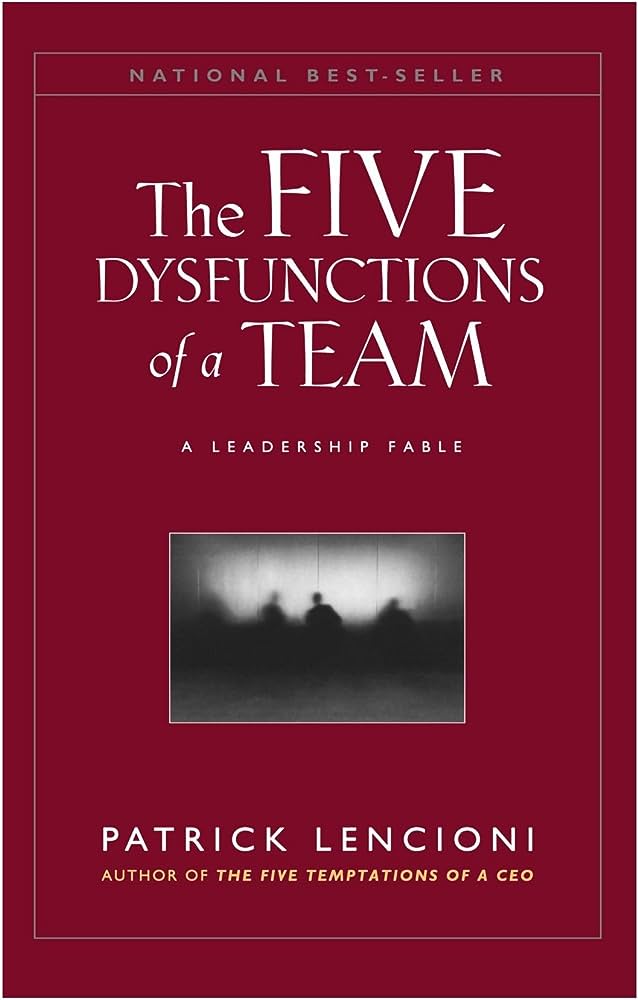
1 Line Summary
“The Five Dysfunctions of a Team” is a book written by Patrick Lencioni, which illustrates the common pitfalls that teams face and provides strategies for overcoming them.
What Will You Learn
Here are some benefits of reading the book. You will learn how to:
- build trust within your team,
- deal with conflict productively,
- get everyone on the team committed to the same goals,
- hold each other accountable,
- focus on results.
Best Quotations from the Book
- “The absence of trust is not the absence of conflict; it’s the presence of fear.”
- “The fundamental attribution error is the tendency of human beings to attribute the negative behaviors of their colleagues to their intentions and the positive behaviors to situational factors.”
- “Conflict is not the enemy of performance; it’s an essential ingredient.”
- “Commitment is not about agreeing; it’s about carrying your weight.”
- “Accountability is the glue that binds commitment.”
- “Meetings are a necessary evil, but they can also be a great opportunity for teams to build trust, resolve conflict, and make progress on their goals.”
- “The best teams are not the ones that never have conflict. They are the ones that have conflict and are able to resolve it productively.”
Book Summary
Here is a summary of the five dysfunctions of a team for you:
1. Absence of Trust
Team members do not trust each other. They are afraid to be vulnerable or to share their true thoughts and feelings. This can lead to a lack of communication and collaboration, and it can make it difficult for the team to make decisions.
2. Fear of Conflict
Team members avoid conflict at all costs. They are afraid of hurting each other’s feelings or of making waves. This can lead to problems being swept under the rug, and it can prevent the team from addressing issues that need to be addressed.
3. Lack of Commitment
Team members are not committed to the team’s goals or to each other. They are more interested in their own individual goals than in the team’s goals. This can lead to a lack of effort and a lack of follow-through, and it can make it difficult for the team to achieve its goals.
4. Avoidance of Accountability
Team members do not hold each other accountable for their actions. They are afraid of confrontation or of hurting each other’s feelings. This can lead to a lack of responsibility and a lack of improvement, and it can make it difficult for the team to achieve its goals.
5. Inattention to Results
Team members are not focused on achieving results. They are more interested in the process than in the outcome. This can lead to a lack of focus and a lack of urgency, and it can make it difficult for the team to achieve its goals.
How to Build Good Teams
Here are some specific things that teams can do to overcome the five dysfunctions:
- Build trust: Team members need to feel safe being vulnerable and sharing their true thoughts and feelings. This can be done by creating a culture of openness and honesty, and by being supportive and understanding of each other.
- Deal with conflict productively: Conflict is inevitable in teams, but it doesn’t have to be destructive. Team members need to learn how to deal with conflict productively, so that it can be used as an opportunity to improve the team’s decision-making and problem-solving skills.
- Get everyone committed to the same goals: Team members need to be committed to the team’s goals and to each other. This can be done by clearly articulating the team’s goals, and by making sure that everyone understands and agrees with them.
- Hold each other accountable: Team members need to hold each other accountable for their actions. This can be done by setting clear expectations, and by providing regular feedback.
- Focus on results: Team members need to be focused on achieving results. This can be done by setting clear goals, and by tracking progress towards those goals.
If you want to create a high-performing team that achieves great things, then you need to read The Five Dysfunctions of a Team. This book will teach you how to overcome the five dysfunctions that prevent teams from reaching their full potential.
Refer: “Extreme Ownership”, “Dare to Lead”, “The 4 Disciplines of Execution”, “The 5 Levels of Leadership” and “Relation between Self Awareness and Effective Leadership“


Pingback: “The 4 Disciplines of Execution” by Chris McChesney, Sean Covey, and Jim Huling Shortform Book Summary -
Pingback: “Dare to Lead” by Brene Brown: Book Summary -
Pingback: “The First 90 Days” by Michael Watkins: Book Summary -
Pingback: “Energize Your Workplace” by Jane E. Dutton: Book Summary -
Pingback: “The First 90 Days” by Michael Watkins: Book Summary -
Pingback: “Dare to Lead” by Brene Brown: Book Summary
Pingback: “Energize Your Workplace” by Jane E. Dutton: Book Summary -
Pingback: "The Power of Intentional Leadership": Book Summary
Pingback: “How to Lead Smart People” : Book Summary »